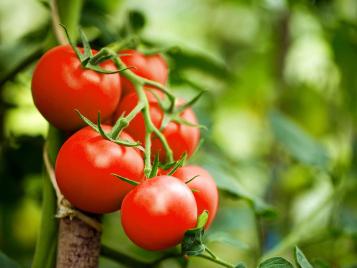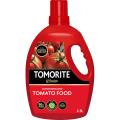

How to grow tomato plants at home
Nothing beats the taste of your own home-grown tomatoes, freshly-picked and warm from the summer sun. Slice into a summer salad, use as pizza toppings, or add some depth to a curry, chili or spaghetti Bolognese. Whether you’re growing them in greenhouses, pots or hanging baskets, our guide tells you all you need to know about growing tomatoes.
Tomato varieties
If you’re new to growing tomatoes, it’s worth getting familiar with some of the terminology. For a start, there are several different types of tomato: salad tomatoes (the round, red, average-sized tomato you’ll see in supermarkets), small, tangy and sweet cherry tomatoes, oval plum tomatoes with few seeds (ideal for cooking), and large, juicy, flavoursome beefsteak tomatoes.
Tomato plants are divided into cordon and bush types, dependent on how they grow. Cordon tomatoes (also sometimes called ‘indeterminate’ tomatoes) grow tall, producing one main stem that needs to be trained up a cane or other support. Bush tomatoes, as the name suggests, grow into short, bushy plants. They don’t need training, but may need some additional support when laden with fruit. Bush tomatoes are sometimes also called ‘determinate’ tomatoes. Here are a few tomato varieties to look out for:
- Tomato ‘Alicante’: a high-yielding cordon tomato
- Tomato ‘Big Boy’: a full-flavoured beefsteak cordon tomato
- Tomato ‘Shirley’: a popular high-yielding cordon tomato
- Tomato ‘Gardener’s Delight’: a cordon type bearing tangy cherry tomatoes
- Tomato ‘Tumbling Tom’: a bush type with masses of tasty cherry tomatoes
Where to grow tomatoes

Growing tomatoes in greenhouses gives you a longer growing season, and also reduces the risk of diseases such as blight, but tomatoes can also be grown outside in a sheltered, sunny spot.
They can be planted directly in the ground in rich, fertile, well-drained soil, or grown in pots filled with good multipurpose compost.
Equipment list for growing tomatoes
To grow tomatoes at home in your garden, you will need:
- 9cm pots for sowing seeds
- 25-30cm diameter pots (if growing tomatoes as container plants)
- General-purpose balanced liquid feed such as Miracle-Gro Performance Organics All-Purpose Plant Food
- Tomato feed such as Tomorite Liquid Tomato Food
- Multipurpose compost such as Miracle-Gro Premium All Purpose Compost
- Canes
- String
- Dibber
- Spade
How to grow tomatoes from seed
If you have a heated greenhouse, you can start sowing tomatoes in late winter. Otherwise sow indoors in early spring.
- Fill 9cm pots with multipurpose compost.
- Sow a seed on top of the compost in each pot, then cover it lightly with a thin layer of compost.
- Water the pots, cover with clingfilm and place in a greenhouse or on a sunny windowsill.
- Once the seeds have germinated, remove the clingfilm. Water the pots regularly to keep the compost moist.
- When the seedlings are about 15cm tall, plant them in their final locations.
How to plant tomatoes outdoors
- Check the weather report before deciding when to plant tomatoes outdoors and wait until all danger of late frosts is past, usually around late May or early June.
- Before planting, prepare the ground by digging in lots of compost or well-rotted farmyard manure.
- Harden seedlings off for a week before planting outside, by putting the seedlings outside in their pots during the day and bringing them back inside at night.
How to grow tomatoes in planters
1. Check the weather report before deciding when to plant tomatoes outdoors and wait until all danger of late frosts is past, usually around late May or early June.
2. Harden seedlings off for a week before moving to outdoor planters, by putting the seedlings outside in their pots during the day and bringing them back inside at night.
3. Transfer tomato plants to a large gro-bag and water them in.
Caring for tomato plants
The secret to caring for tomato plants is regular watering and feeding, especially once fruits start to develop. Aim for a consistent moisture level in the soil – if the plants dry out and then get soaked to compensate, the fruits will take up too much water and split. In wet weather, lay a thick layer of compost around outdoor tomatoes to help keep soil moisture levels constant.
Feed plants fortnightly, starting with a balanced liquid feed. Once fruits start to appear, switch to a tomato feed.
For cordon tomatoes, tie the main stems back to support canes as they grow, and remove the small side shoots that appear in the angles between side stems and the main stem. Once five trusses (side stems bearing leaves, flowers and fruit) have developed, pinch off the growing tip of the main stem. This will focus the plant’s energy on producing more fruit.
For bush types, there’s no need to remove side shoots or pinch out growing tips. However, you may need to support heavily-laden branches with canes.
When to harvest tomatoes
Greenhouse-grown tomatoes should be ripe by mid-summer. Tomatoes grown outdoors will ripen later in mid- to late summer, depending where you are in the UK.
Ripe tomatoes are the same colour all over. They can be left on the plant for up to two weeks once ripe, so pick them as you need them.
As temperatures drop in autumn, tomatoes will eventually stop ripening on the plants. However, you can still ripen them indoors. In October, cut off all remaining tomatoes and place them indoors in a paper bag together with a banana or an apple. These fruits give off a gas called ethylene which encourages the tomatoes to ripen. The process takes about two weeks. Check the bag periodically and remove tomatoes as they ripen.
Common tomato plant problems, pests and diseases
Tomato blight
Blight is the biggest problem for tomato growers. This is an air-borne fungal disease most likely to occur in warm, humid conditions. Brown patches on leaves are the first indication of blight, and should be removed and disposed of immediately.
Unfortunately, there’s no treatment for tomato blight but there are precautions you can take to reduce the risk:
- Choose disease resistant cultivars. Several varieties have been bred to have increased resistance to blight, although none are guaranteed disease-resistant.
- When watering plants, water the soil, not the leaves
Greenhouse-grown plants are less at risk of blight, but can be attacked by red spider mite and aphids. To discourage red spider mite, mist plants regularly, and wipe aphids off with a damp cloth.
Whitefly
Whitefly live on the underside of the tomato leaves and weaken the plant by sucking the sap of plants.
- An insecticide spray will control whitefly
Tomato leaf mould
Tomato leaf mould is a common fungal disease of tomato plants growing in greenhouses. Brown leaves and fruit as well as bleached spots on the flower petals are typical symptoms of this disease. It is rarely seen on outdoor plants.
- Remove and destroy all affected plant parts.
- For plants growing under cover, increase ventilation and, if possible, the space between plants.
- Try to avoid wetting the leaves when watering plants, especially when watering in the evening,
- Copper-based fungicides can be used to control diseases on tomatoes.
Blossom end rot
Blossom end rot is caused by lack of calcium in the fruit. A circular patch varying in size and colour (from brown to black) at the bottom of tomato fruits is the classic symptom of blossom end rot.
- Keep soil and compost consistently moist
- Apply a liquid tomato fertiliser
Key features of tomatoes
| Flowering season(s) | Spring, Summer |
|---|---|
| Foliage season(s) | Spring, Summer, Autumn |
| Sunlight | Full sun |
| Soil type | Chalky, Clay, Loamy, Sandy |
| Soil pH | Neutral |
| Soil moisture | Moist but well-drained |
| Ultimate height | Up to 1.8m (6ft) |
| Ultimate spread | Up to 60cm (2ft) |
| Time to ultimate height | 5 months |
FAQs
Can I grow tomatoes at home?
Yes, you can grow tomatoes at home in the UK, either in containers, greenhouses, or outdoors. Choose varieties suited to UK climates, like cherry or outdoor beefsteak tomatoes.
Do tomatoes grow indoors?
Yes, tomatoes can grow indoors in the UK. Use grow lights, warm conditions, and a sunny spot to encourage healthy growth. Consider dwarf or cherry tomato varieties ideal for indoor cultivation.



